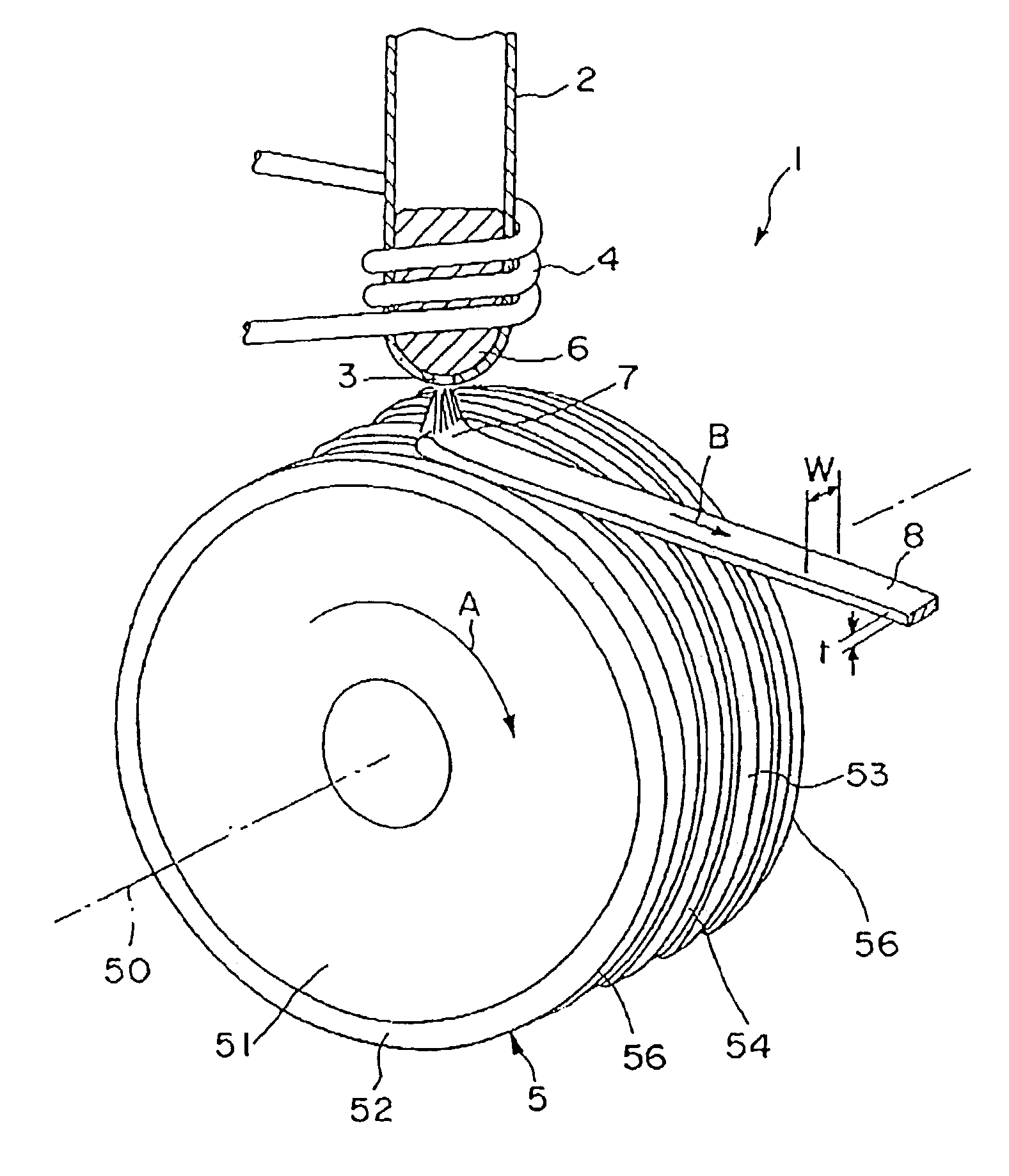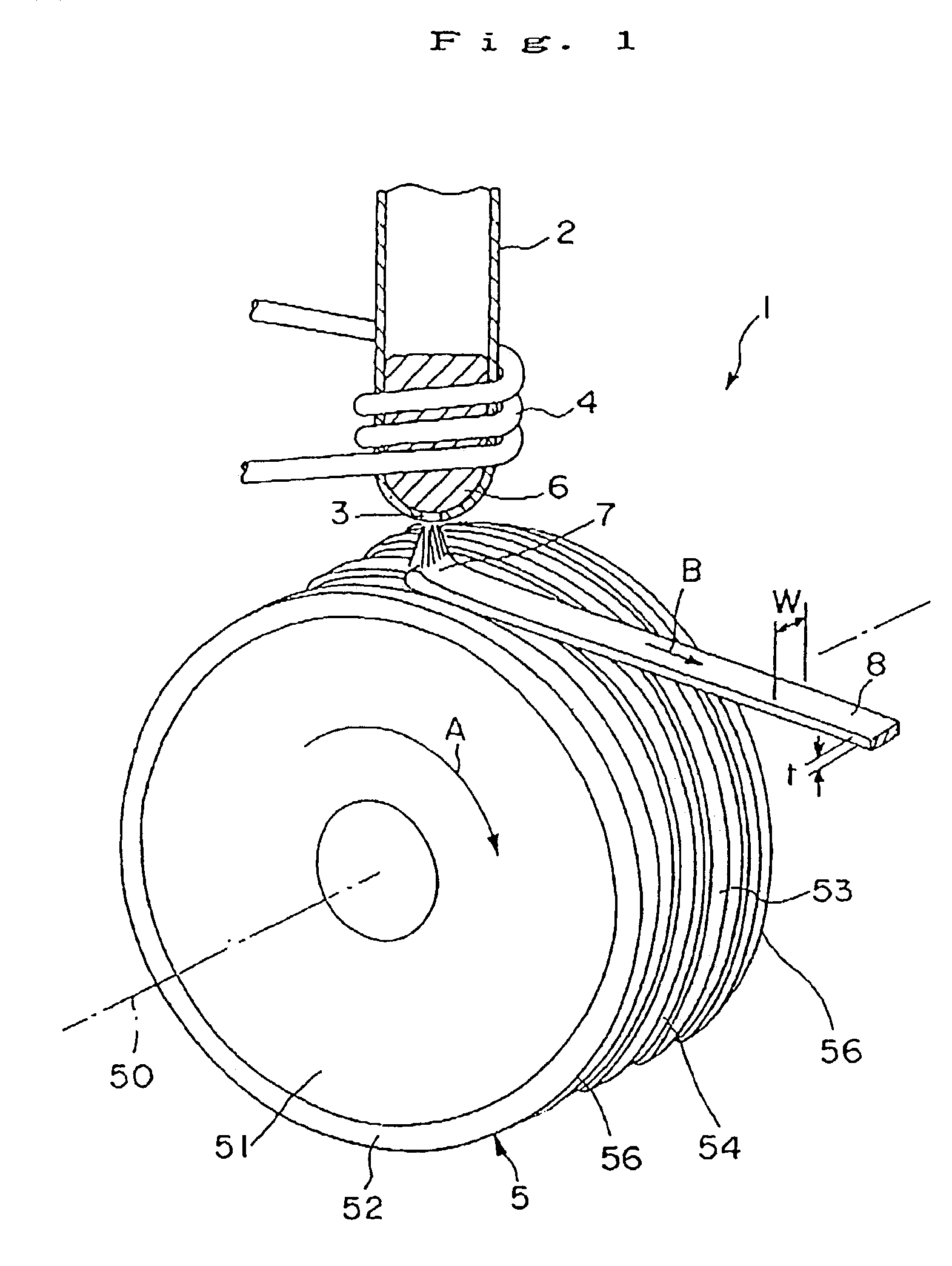Magnetic material manufacturing method, ribbon-shaped magnetic materials, powdered magnetic material and bonded magnets
a magnetic material and manufacturing method technology, applied in the direction of magnets, magnetic bodies, transportation and packaging, etc., can solve the problems of reducing magnetic properties, reducing magnetic properties, and reducing the maximum magnetic energy product (bh)max of magnetic powder, so as to achieve excellent magnetic properties, high maximum magnetic energy product (bhmax), and high magnetic properties
- Summary
- Abstract
- Description
- Claims
- Application Information
AI Technical Summary
Benefits of technology
Problems solved by technology
Method used
Image
Examples
example 1
[0201]A cooling roll A having the dimple correcting means shown in FIGS. 1 to 3 was manufactured, and then a melt spinning apparatus equipped with the cooling roll A shown in FIG. 1 was prepared.
[0202]The cooling roll A was manufactured as follows.
[0203]First, a roll base (having diameter of 200 mm and width of 30 mm) made of a copper (having heat conductive of 395 W·m−1·K−1 at t a temperature of 20° C. and coefficient of thermal expansion of 16.5×10−6K−1 at a temperature of 20° C.) was prepared, and then it was ground so as to have a mirror finishing outer circumferential surface with a surface roughness of Ra 0.07 μm.
[0204]Then, a plurality of grooves 54 which extend in parallel with the rotational direction of the roll base were formed by cutting.
[0205]As a result of the formation of the grooves, the portions remaining between the adjacent grooves 54 were used as ridges.
[0206]Next, a surface layer of ZrC (a kind of ceramics) (having heat conductivity of 20.6 W·m−1·K−1 at t a temp...
example 2
[0235]Ten types of melt spun ribbons (sample Nos. 2a, 2b, 2c, 2d, 2e, 2f, 2g, 2h, 2i and 2j) were manufactured using the cooling rolls A to J in the same manner as Example 1 described above excepting that the alloy composition of each melt spun ribbon was Nd11.5Febal.B4.6.
[0236]Then, for each of the ten melt spun ribbons (samples Nos. 2a to 2j) which were respectively manufactured using each of the cooling rolls (A to J), the surface condition thereof was observed by a scanning electronic micrometer (SEM). As a result, it was confirmed that in each of the melt spun ribbons of the samples Nos. 2a to 2i (present invention), the surface shape or form (groove or ridges) of the cooling roll was transferred to the roll contact surface of the melt spun ribbon so that corresponding ridges or grooves are formed therein and dimples are produced with a state that they are divided by thus formed ridges or grooves (in particular, the grooves). In contrast, in the melt spun ribbon of the sample N...
example 3
[0250]Ten types of melt spun ribbons (sample Nos. 3a, 3b, 3c, 3d, 3e, 3f, 3g, 3h, 3i and 3j) were manufactured using the cooling rolls A to J in the same manner as Example 1 described above excepting that the alloy composition of each melt spun ribbon was Nd14.2(Fe0.85Co0.15)bal.B6.8.
[0251]Then, for each of the ten melt spun ribbons (samples Nos. 3a to 3j) which were respectively manufactured using each of the cooling rolls (A to J), the surface condition thereof was observed by a scanning electronic micro meter (SEM). As a result, it was confirmed that in each of the melt spun ribbons of the samples Nos. 3a to 3i (present invention), the surface shape or form (groove or ridges) of the cooling roll was transferred to the roll contact surface of the melt spun ribbon so that corresponding ridges or grooves are formed therein and dimples are produced with a state that they are divided by thus formed ridges or grooves (in particular, the grooves). In contrast, in the melt spun ribbon of...
PUM
| Property | Measurement | Unit |
|---|---|---|
| depth | aaaaa | aaaaa |
| height | aaaaa | aaaaa |
| area | aaaaa | aaaaa |
Abstract
Description
Claims
Application Information
 Login to View More
Login to View More - R&D
- Intellectual Property
- Life Sciences
- Materials
- Tech Scout
- Unparalleled Data Quality
- Higher Quality Content
- 60% Fewer Hallucinations
Browse by: Latest US Patents, China's latest patents, Technical Efficacy Thesaurus, Application Domain, Technology Topic, Popular Technical Reports.
© 2025 PatSnap. All rights reserved.Legal|Privacy policy|Modern Slavery Act Transparency Statement|Sitemap|About US| Contact US: help@patsnap.com



